The Hidden Divide in Digital Transformation
Two enterprises can deploy the same technologies, operate within the same market, and pursue the same ambition of digital transformation — yet arrive at entirely different outcomes. One builds a system that learns and adapts with every decision; the other modernizes infrastructure but struggles to translate progress into performance. The difference reveals an emerging fault line in enterprise evolution.
As explored in Digital Transformation: What It Is, Why It Matters, and How It’s Reshaping Business, transformation redefined how value is created. It established technology as the architecture of strategy and culture as the mechanism of change. In practice, this redefinition has advanced unevenly. Some organizations integrate strategy, governance, and learning into a coherent system; others continue to advance in disconnected efforts that improve processes without strengthening adaptability.
Evidence from recent studies quantifies this divide. McKinsey’s 2023 analysis shows that only about 30 percent of transformation programs meet their objectives. BCG’s research finds that digital leaders achieve roughly twice the EBIT growth and five times the innovation velocity of their peers. Deloitte’s studies reinforce the same pattern: transformation success depends less on investment level and more on integration—how leadership, decision systems, and culture interact to sustain change.
The divide is not defined by technology access but by organizational capacity—the ability to learn, adapt, and lead at the speed of change. Enterprises that align ambition, capability, and culture develop compounding advantage. Those that fail to synchronize these dimensions lose momentum as complexity grows.
The current wave of innovation has widened the distance further. Artificial intelligence, platform ecosystems, and data-driven decision networks reward integration and coherence, favoring those already designed to adapt. For others, progress has become fragmented—a cycle of experimentation without lasting transformation.
The consequences extend beyond technology. They influence competitiveness, talent retention, and the durability of enterprise purpose. Understanding this divide is essential to understanding transformation itself. This article explores the structural asymmetries that shape uneven progress and the leadership disciplines that convert digital intent into sustainable capability.
Uneven Evolution: Why Transformation Progress Diverges
Structural Asymmetries Beneath the Surface
Digital transformation was conceived as an enterprise-wide recalibration of how organizations operate and compete. In theory, every function—technology, operations, culture, and governance—should evolve together. In reality, progress often unfolds unevenly. Some enterprises move forward through synchronized change, while others advance in increments that never cohere into a unified system.
As detailed in Evolution of Digital Transformation: From IT Modernization to Enterprise Reinvention, the early stages of transformation concentrated on infrastructure and process optimization. Those investments improved performance but rarely altered how organizations learned, governed, or decided. Many enterprises continue to upgrade technology faster than they evolve the structures that direct it. Modernization expanded technical capacity, but institutional maturity did not always keep pace.
This uneven rhythm reflects four recurring asymmetries — each small in isolation, but decisive in combination.
1. Strategic Alignment
Transformation succeeds when digital ambition is inseparable from business strategy. Where alignment is strong, technology investments extend enterprise purpose and reinforce decision logic. Where it weakens, transformation becomes a sequence of initiatives detached from measurable outcomes. The presence or absence of this connection determines whether digital capability compounds over time or dissipates after each project cycle.
2. Cultural Adaptability
Culture governs how readily organizations interpret and act on new information. In adaptive cultures, experimentation converts uncertainty into learning. In rigid ones, technology is implemented without changing underlying behavior. Research from MIT Sloan shows that cultural maturity explains nearly twice as much variance in transformation success as technology spending. Adaptability is not a soft variable—it defines how knowledge becomes capability.
3. Capability Readiness
Digital progress depends on the alignment of skills, data literacy, and process design. When these develop unevenly, friction emerges: advanced analytics without adoption, automation without accountability, data without governance. Mature organizations treat capability as an interconnected portfolio — technical, analytical, and operational — each reinforcing the other.
4. Governance Maturity
Governance determines whether transformation endures beyond its initial momentum. Coherent oversight links investment, risk, and performance in a continuous review cycle. Fragmented governance disperses accountability and weakens focus. In organizations where governance maturity is low, transformation remains episodic—activated by urgency, paused by complexity, and rarely sustained as discipline.
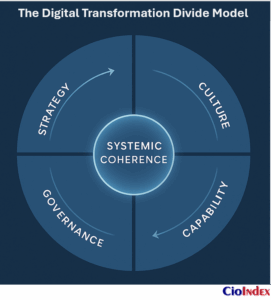
Together, these asymmetries form what can be described as The Digital Transformation Divide Model — a continuum that maps how enterprises evolve across interdependent dimensions. When progress remains balanced, transformation compounds naturally: learning supports innovation, and governance sustains execution. When one dimension lags, friction in that area slows the entire system.
This model reframes transformation as an exercise in synchronization. Each dimension — strategy, culture, capability, and governance — advances on its own timeline. The organizations that move forward consistently are those able to align these timelines into a single rhythm of adaptation. In them, technology does not lead or follow — it integrates.
The challenge for most enterprises is not speed but coherence. As digital complexity grows, progress depends less on how much is implemented and more on how deeply systems and behaviors interconnect. Transformation maturity, therefore, is not a measure of completion but of synchronization — the extent to which the organization evolves as one coordinated system.
| Dimension | Low Maturity (Fragmented) | High Maturity (Synchronized) |
|---|---|---|
| Strategy | Digital initiatives operate independently of enterprise strategy. Technology adoption is treated as an outcome rather than an enabler. | Digital ambition is embedded within business direction. Technology, investment, and performance are guided by the same strategic intent. |
| Culture | Change depends on compliance and direction. Information moves vertically, and learning remains localized. | Learning and experimentation are institutionalized. Information flows freely, and collective intelligence shapes decisions. |
| Capability | Skills, data, and process maturity evolve unevenly. Automation scales faster than understanding or accountability. | Skills, data literacy, and process design mature together. Capability is developed as a connected portfolio that compounds over time. |
| Governance | Oversight is reactive, limited to programs or crises. Accountability and risk are treated as separate disciplines. | Governance operates as continuous orchestration. Investment, risk, and performance oversight are integrated into a single management rhythm. |
Transformation maturity depends on the synchronization of strategic, cultural, capability, and governance development. Fragmentation in any one dimension constrains the others.
The Performance Gap: What the Data Shows
Evidence from the Field
The divergence between transformation leaders and those still in transition is now quantifiable. What began as differences in execution has evolved into measurable variations in resilience, adaptability, and long-term performance. Transformation maturity is no longer an abstract score; it is visible in recovery speed, decision coherence, and the continuity of innovation during disruption.
Deloitte’s 2024 Digital Maturity and Return on Transformation study illustrates this relationship clearly. Enterprises that integrate digital oversight into governance and strategy realize, on average, a 21 percent higher Return on Transformation (RoT)—a measure of sustained benefit relative to investment—than those that treat transformation as a program of discrete initiatives. These organizations maintain growth trajectories even in volatile markets because their systems are designed to adjust rather than reset when conditions change.
Similar findings emerge from PwC’s 2023 CEO Survey. Executives from digitally mature organizations were three times more confident in their ability to adapt operating models during market disruptions and twice as likely to view transformation as a continuous discipline rather than a time-bound milestone. McKinsey’s resilience benchmarking supports this view: organizations with embedded digital governance recovered operational stability 40 percent faster after external shocks than those with siloed or fragmented oversight.
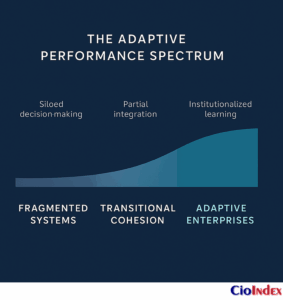
Sector-level evidence reinforces the same pattern. In healthcare, digital maturity correlates strongly with system continuity—hospitals using integrated data platforms sustained patient-care metrics during pandemic disruptions while others experienced severe operational degradation. In retail, companies with unified digital experience architectures maintained customer retention rates 25 percent higher than peers that treated online and in-store channels separately. In manufacturing, firms that synchronized analytics, supply chain automation, and workforce reskilling achieved measurable gains in output reliability and product cycle efficiency.
Beyond performance metrics, digital maturity also alters decision behavior. MIT Sloan’s Future Enterprise research identifies decision velocity—the time between data acquisition and executive action—as a defining metric of competitive advantage. High-maturity enterprises make strategic decisions nearly twice as fast as their peers because learning and accountability are built into their operating architecture. Information moves through the system with minimal distortion, allowing leaders to focus on interpretation rather than reconciliation.
Gartner’s 2024 governance analysis complements this picture. Boards that incorporate digital readiness into performance reviews report greater alignment between strategic goals and technology outcomes, leading to more consistent transformation gains across multiple business cycles. In these organizations, transformation no longer depends on project momentum; it becomes an embedded management discipline.
Taken together, the data defines a widening spectrum of enterprise performance. At one end are organizations where digital maturity functions as an adaptive system, sustaining capability under pressure and compounding advantage over time. In the middle are enterprises that have achieved partial progress—technologically capable but operationally inconsistent. At the lower end remain those where transformation remains fragmented, yielding temporary improvement without lasting resilience.
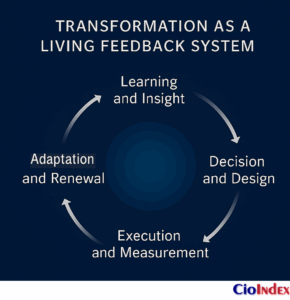
The performance gap therefore reflects more than financial variance; it represents a difference in organizational metabolism. Digital leaders have institutionalized adaptability—the ability to sense, decide, and adjust with precision. Others continue to operate with episodic change, where progress depends on individual projects or leadership interventions rather than systemic learning.
Understanding this gap clarifies why transformation success accumulates unevenly. It is not the scale of technology that separates leaders from followers, but the capacity to translate information into action at enterprise speed. The next section explores how that capacity develops through leadership design—how structure, behavior, and decision authority determine whether transformation becomes a sustainable capability.
| Performance Indicator | Fragmented Systems | Transitional Cohesion | Adaptive Enterprises |
|---|---|---|---|
| Resilience (Recovery Speed) | Reactive response to change; systems return to baseline slowly. | Partial readiness; recovery improves but remains situational. | Continuous adaptability; systems reconfigure fluidly during disruption. |
| Decision Velocity | Hierarchical and slow; information filtered through layers. | Faster collaboration; some autonomy, but constrained by hierarchy. | Distributed and data-driven; learning translates rapidly into coordinated action. |
| Innovation Throughput | Sporadic and dependent on individual effort. | Structured but often limited to specific functions. | Continuous and systemic; innovation embedded into daily operations. |
| Return on Transformation (RoT) | Diminishing returns over time; initiatives lose momentum. | Variable results across functions; value dependent on leadership continuity. | Sustained and compounding; learning improves efficiency and performance. |
Digital maturity compounds over time. The most adaptive enterprises convert speed of learning into sustained advantage.
Case Evidence: Patterns of Leadership and Design
Learning from Enterprise Experience
The digital transformation divide becomes most visible when viewed through organizational design—how leadership structures connect purpose, capability, and governance. In each of the following cases, the presence or absence of alignment across these dimensions explains the difference between transformation that compounds and transformation that plateaus.
Unilever — Integrating Purpose, Governance, and Data
Unilever’s transformation has been guided by leadership that treats digital capability as inseparable from sustainability and long-term value. The company built its transformation governance around three interconnected pillars: data accessibility, consumer intelligence, and responsible innovation. Its Digital Council—composed of senior leaders across functions—oversees progress using shared metrics that combine commercial and environmental performance. By linking purpose with data and accountability, Unilever turned digital transformation into a management discipline rather than a sequence of technology programs. The result is continuity: every digital initiative reinforces both brand growth and enterprise responsibility, creating coherence that endures through leadership transitions.
Ford Motor Company — The Challenge of Synchronization
Ford represents an enterprise moving through transformation without yet completing it. The company invested heavily in connected-vehicle platforms, software services, and electric-mobility ecosystems. These advances expanded its technical capability but exposed unevenness in organizational alignment. Traditional manufacturing processes, legacy decision structures, and supply-chain dependencies often move at a different rhythm from digital development cycles. Ford’s leadership has responded by introducing new digital operating groups and a centralized data organization, yet cultural and governance integration remain in progress. The company’s trajectory illustrates the middle of the divide—significant modernization accompanied by the friction of partial synchronization.
NVIDIA — Coherence by Design
NVIDIA provides a contrasting illustration of transformation that functions as an integrated system. From its origin as a graphics-chip company, NVIDIA evolved into a platform enterprise at the intersection of AI, data, and accelerated computing. Leadership continuity and a unified architectural vision allowed technology, culture, and governance to develop in parallel. Decision velocity is maintained through tight feedback loops between engineering, product strategy, and ecosystem partners. Because organizational learning and product innovation occur within the same operating logic, adaptation is continuous rather than episodic. NVIDIA’s model demonstrates what coherence looks like when transformation is built into design from the beginning.
U.S. Digital Service (USDS) — Institutionalizing Change in the Public Sector
The U.S. Digital Service was created to modernize federal technology and redesign digital interactions between government and citizens. Its mission reflects many of the challenges faced by large legacy enterprises: complex governance, fragmented accountability, and cultural inertia. Over the past decade, USDS teams have introduced agile methods, user-centric design, and cross-agency collaboration, producing clear improvements in speed and service quality. Progress, however, varies by department, revealing how uneven structural alignment can limit scalability. Where leadership commitment and policy governance coincide, modernization advances; where oversight remains siloed, gains taper. The case illustrates that even with resources and expertise, transformation coherence must be continuously cultivated.
Across these diverse contexts, the same pattern appears. Digital transformation advances when leadership designs the organization as a connected system—linking strategy, learning, and governance into a single feedback loop. Where that connection weakens, progress fragments and must be restarted with each initiative. The divide is therefore not a question of ambition or investment; it is a reflection of structural design and leadership coherence.
Leadership as the Integrator
The Human Architecture of Transformation
Leadership determines whether digital transformation becomes a continuous capability or a temporary phase. The divide between progress and stagnation often narrows to how leaders structure decision authority, align incentives, and cultivate learning across the enterprise. In organizations where leadership acts as an integrator, technology, governance, and culture operate as interdependent systems rather than as parallel domains.
Research from MIT Sloan, Deloitte, and Korn Ferry consistently links transformation success to specific leadership attributes. The most effective leaders combine systems thinking with emotional intelligence, using governance and culture as instruments of integration. They design organizations that are transparent in information flow, distributed in decision-making, and unified by shared principles of accountability. These leaders do not delegate transformation to digital teams; they embed it into how the enterprise defines value and performance.
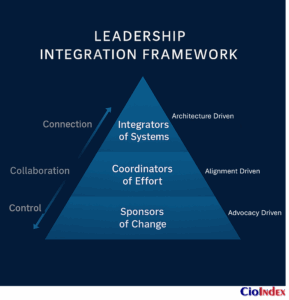
Three leadership archetypes describe how integration maturity evolves:
1. Sponsors of Change
Sponsors champion transformation but often view it as an initiative requiring advocacy rather than redesign. Their focus is on resourcing and visibility. While sponsorship can accelerate early adoption, it seldom restructures how decisions are made or how learning circulates. Once sponsorship wanes, progress slows because the system itself remains unchanged.
2. Coordinators of Effort
Coordinators establish alignment across projects and functions. They improve communication and governance, ensuring that objectives and metrics are consistent. Coordination creates short-term coherence but can still rely on central control. When the environment shifts, the model requires continual recalibration from the top, limiting adaptability.
3. Integrators of Systems
Integrators treat transformation as an organizational operating model. They align structures, behaviors, and incentives to ensure that digital capability reinforces strategic intent. Integrators balance autonomy with accountability—creating conditions where experimentation scales and governance evolves in parallel. Decisions about technology, investment, and culture occur within a unified framework that links insight to execution.
| Leadership Archetype | Primary Focus | Core Strength | Systemic Limitation | Transformation Outcome |
|---|---|---|---|---|
| Sponsors of Change | Advocacy and resource mobilization | Energy, visibility, and momentum in early phases | Limited redesign of decision systems; progress stalls after sponsorship ends | Acceleration without endurance |
| Coordinators of Effort | Cross-functional alignment and process coherence | Improved consistency and communication across programs | Overreliance on central control; adaptability constrained | Coherence achieved, adaptability limited |
| Integrators of Systems | Architecture of learning, governance, and culture | Structural coherence, distributed decision-making, and systemic learning | Requires strong cultural readiness to sustain | Continuous transformation and enterprise resilience |
Leadership maturity evolves from advocacy to systemic integration. The integrator role unites structure, behavior, and learning into one operating model.
Empirical evidence supports this progression. Deloitte’s Human Capital Trends survey finds that enterprises led by integrator-style executives achieve 30 percent higher transformation durability over five years than those led by coordinators or sponsors. The difference lies in feedback architecture: integrators institutionalize mechanisms that translate information into adaptation without relying on episodic leadership interventions.
In mature organizations, integration becomes visible in how leaders manage three relationships:
- Between Strategy and Execution — ensuring that digital goals shape, and are shaped by, operational decisions.
- Between Technology and Culture — aligning technical progress with human capability and learning velocity.
- Between Governance and Innovation — balancing freedom to experiment with accountability for outcomes.
When these relationships function in balance, leadership ceases to be a hierarchy and becomes an ecosystem—a network of roles that interpret, connect, and guide rather than command. Integration is therefore less about structure than about connectivity: the deliberate linking of vision, information, and trust across the enterprise.
The capacity to lead through integration also redefines accountability. Integrators measure success not by the volume of initiatives launched but by the continuity of learning achieved. Their organizations retain coherence through transition, absorbing change without losing direction. This behavioral consistency distinguishes enterprises that evolve naturally from those that must continually restart their transformation efforts.
Leadership, then, is not an overlay to digital transformation but its central operating mechanism. It determines whether systems learn together or apart, whether governance enables curiosity or constrains it. As the pace of technological and market change accelerates, the integrative function of leadership becomes the most reliable predictor of enterprise endurance. It is through this capacity to align purpose, information, and accountability that transformation moves from aspiration to continuity.
Four Dimensions of the Divide
Mapping the Systemic Gaps
Digital transformation matures unevenly because the systems that support it evolve at different speeds. Strategy, culture, capability, and governance form the four dimensions through which coherence is either strengthened or lost. Each represents a distinct domain of enterprise function; together, they define how effectively an organization translates ambition into sustained performance.
Strategic Dimension — From Ambition to Alignment
In the most mature organizations, digital ambition is inseparable from business strategy. Strategic intent shapes investment logic, and technology informs the design of new value propositions. Where the divide appears, strategy and digital execution operate on separate planes: vision expands faster than implementation, or technology initiatives move without a shared direction. The result is activity without acceleration. Strategic maturity depends on clarity of purpose and the mechanisms that keep decisions aligned with it—portfolio governance, prioritization, and transparent measurement of progress.
Cultural Dimension — The Flow of Learning and Trust
Culture determines how information becomes understanding and how understanding becomes action. In adaptive organizations, learning is continuous and distributed. Teams experiment within clear ethical and operational boundaries, and trust enables ideas to move across functions. Where culture remains fragmented, information circulates but insight does not. Employees comply with systems they do not feel connected to, and transformation stalls in perception rather than execution. Cultural maturity is evident in the quality of dialogue—how easily feedback travels from the edges of the enterprise to its center and back again.
Capability Dimension — The Balance of Skill, Data, and Design
Capability reflects how technical expertise, data fluency, and operational design interact. Many organizations invest heavily in technology but unevenly in the skills and processes required to use it coherently. This creates what analysts describe as capability asymmetry: automation without understanding, analytics without accountability, or data without governance. Mature enterprises integrate these elements as a portfolio of strengths, ensuring that capability compounds over time rather than fragmenting across silos. Development plans, data literacy programs, and cross-functional design reviews all contribute to this balance.
Governance Dimension — The Discipline of Coherence
Governance transforms ambition into reliability. It is the structure through which progress is monitored, risks are managed, and integrity is preserved. Boards and executives that embed digital oversight into performance evaluation maintain a continuous line between strategic intent and operational behavior. Gartner’s global board study found that such enterprises are nearly twice as likely to sustain transformation gains beyond five years. In contrast, where governance remains episodic—activated during crises or program launches—alignment fades, and decisions lose cumulative impact. Governance maturity is measured not by control but by consistency: how dependably the organization learns, decides, and acts as one.
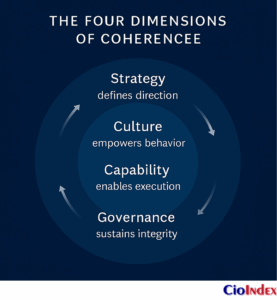
Across these dimensions, the divide reveals itself as an imbalance of rhythm. Some parts of the organization accelerate, others hesitate, and the system loses synchronization. Coherence arises when all four evolve in concert—when strategy defines direction, culture mobilizes participation, capability enables execution, and governance sustains integrity. Digital maturity is the state in which these dynamics move together, each reinforcing the other in a steady cycle of awareness and adaptation.
Bridging the Divide: Building Systemic Maturity
Toward Coherence and Continuity
When transformation fragments, the cause is rarely absence of effort; it is absence of integration. Bridging the divide requires restoring the rhythm between the systems that shape enterprise behavior. The organizations that mature most consistently apply a small set of disciplines that keep learning, leadership, and structure aligned over time.
Institutionalizing Learning
Enterprises that sustain progress treat learning as infrastructure. Knowledge is captured, tested, and reapplied through deliberate mechanisms—retrospectives, data reviews, and cross-functional exchanges that convert experience into shared capability. Metrics evolve from project milestones to learning indicators: the speed at which insight becomes decision, or how often feedback translates into process change. Over time, these organizations develop what researchers describe as institutional memory—an adaptive intelligence that outlives individual initiatives.
Aligning Governance with Adaptability
Mature enterprises design governance systems that enable movement rather than restrict it. Oversight functions integrate with operations through transparent data and continuous review cycles. Decision rights are clear but flexible, allowing accountability to shift as new information emerges. This approach turns governance into a stabilizing rhythm: predictable enough to maintain trust, dynamic enough to support change. Boards and executive committees measure progress not by adherence to plan but by the organization’s responsiveness to context.
Measuring Momentum Instead of Completion
Traditional performance models assume transformation ends once defined objectives are met. Systemic maturity replaces that mindset with measurement focused on momentum. The indicators that matter are decision velocity, cross-functional alignment, and resilience under pressure. Some enterprises use “return on learning” ratios—assessing how quickly new knowledge generates operational improvement. Others track adaptability indices linking cycle time, innovation throughput, and employee engagement. These metrics signal whether the organization is evolving as a single, coherent system.
Cultivating Purpose as Operating Logic
Purpose anchors adaptation. In cohesive enterprises, purpose functions as a navigational constant that keeps experimentation aligned with values and outcomes. It clarifies why change occurs and guides trade-offs when data, technology, and human judgment intersect. Without such clarity, transformation accelerates without direction, producing motion rather than progress. Purpose ensures that innovation, governance, and culture remain connected by intent as well as by information.
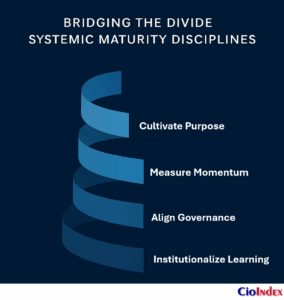
Bridging the divide is therefore less about scale and more about synchronization. The enterprises that succeed in doing so develop architectures that convert insight into coordinated action and systems that learn as they operate. Their maturity is measured not by the number of technologies adopted or programs completed but by the consistency with which they adapt and remain coherent through change. In these organizations, transformation evolves from a project to a property—a defining characteristic of how the enterprise endures.
From Division to Discipline
Sustaining Coherence in an Adaptive Enterprise
Digital transformation reveals as much about organizational behavior as it does about technology. The persistence of the divide shows that progress depends less on innovation itself than on the systems that translate it into continuity. Every enterprise now operates in a cycle of adaptation: learning, deciding, implementing, and adjusting. The distinction between leaders and laggards lies in how consistently that cycle functions across the whole organization.
Enterprises that advance through coherence rather than momentum share a defining characteristic: discipline. Their systems are designed to learn; their governance translates insight into decision; their culture reinforces accountability and curiosity in equal measure. When disruption occurs, these structures do not react—they absorb and reorganize, converting uncertainty into renewal.
For others, transformation remains a collection of initiatives rather than a living system. Progress occurs in bursts, dependent on executive sponsorship or external urgency. Each new wave of investment begins by rebuilding what was already learned but never institutionalized. The cost of this discontinuity is not only financial—it is cognitive. Fragmented systems consume attention faster than they create value.
Bridging the divide requires recognizing transformation as a long-term discipline of coherence. It is not a pursuit of newness but a practice of connection—linking strategy to purpose, learning to governance, and technology to human judgment. In organizations where these connections hold, progress compounds quietly, forming an adaptability that becomes invisible because it is continuous.
The most advanced enterprises no longer describe themselves as transformed; they describe themselves as synchronized. Their maturity lies in balance, not completion—in the ability to evolve without losing direction. Transformation, understood this way, becomes less about digital ambition and more about organizational consciousness: the capacity to remain whole while everything around it changes.
